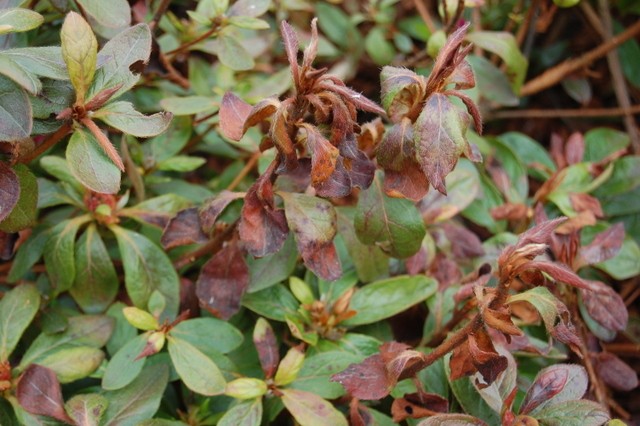What's wrong with my Rhododendron?
The most common pests, diseases and problems of Rhododendron and Azaleas
Rhododendron Expert Glendoick's Kenneth Cox discusses Rhododendron Problems, Pests & Diseases.
Rhododendrons are quite easy to grow as long as you have well drained but moist acidic soil. They wont tolerate deep and dry shade and poor drainage/heavy clay soil. And they wont grow in areas with chalky/limey soil unless in raised beds.
Rhododendrons which are not happy tend to show this by their leaves turning yellow. There are several reasons that this may happen. So why has my rhododendron got yellow leaves? Reasons include: because they are too wet, too dry, planted too deep, starved (needing feeding), soil too alkaline, or soil is compacted:
Why does my rhododendron not flower?
Pest and Disease information adapted from Kenneth Cox's book Rhododendrons and Azaleas a Colour Guide
1. Frost Damage If buds are formed and then turn brown, cause is usually frost. To avoid frosted buds, protect opening buds with fleece or plant later flowering varieties such as deciduous azaleas.
2. Flower buds do not form (flower buds are fatter than growth buds which are usually more pointed. Some varieties, especially species, take many years to flower. You may need to wait till plants are 10 years old for large leaved species for example.
3. If planted in too much shade, will not flower well: best to move to sunnier spot.
4. Fertiliser applied after late June encourages leaves, not flowers. Stop feeding in June.
5. Bud Blast fungus
Bud blast fungus: look for black bristles on the buds. It affects R. caucasicum hybrids such as 'Cunningham's White' in UK. Can be severe in Germany and other countries. Not much can be done about this. If it is very bad, consider destroying the worst affected plants.
Why does my rhododendron with yellow or chlorotic leaves:
 This is a general sign of unhappiness and can have many causes:
This is a general sign of unhappiness and can have many causes:
1. Rhododendron drainage is poor: solution: lift plant and improve soil structure or move to better drained spot. You need to do this before the plant starts to suffer as root problems caused by poor drainage can be fatal.
2. Rhododendron is planted too deep? The rootball should be at or just below the soil surface. If you cant feel the rootball then it is probably planted too deep. Lift the plant. If it has been in for a long time you may see new roots forming near the soil surface. Replant at the correct level. Do not let piles of mulch bury the plant. 10cm of mulch is more than enough. Do not use membrane and bark as rhododendrons dont like this.
3. Rhododendron is starved. Apply fertiliser April-May to Late June.
4. Rhododendron is suffering from lack of water: often due to competition from tree roots. Feed and water the plant and it will probably pick up. Think about thinning the shade or moving the plant if it is suffering.
5. Soil is too alkaline (unlikely in Scotland) pH 6 and higher. Soil acidity is measured by the pH scale. 7 in neutral. Chalky soils tend to be pH 7-9. Rhododendrons need a pH of 4-6. If you have alkaline soil, you will need to build raised beds and plant in peaty soil. Avoid watering with tap water if it is chalky. Use rainwater collected from rooves instead. You can have your soil tested but it is better to ask around as gardeners generally know if the local soil is alkaline or acidic. In Scotland virtually all soil is naturally acidic. Farmers do lime soil for crops but this washes out over 3 years or so. You can lower/acidfy the soil pH before planting by applying sulphur as alumineum or iron sulphate.
6. Mineral Deficiency Rhododendrons need specific minerals. Most of these are found naturally in soils. But in alkaline soil, rhododendrons take up too much calcium and not enough iron. Adding iron chelates or sequestrine can help but most of this time this is an expensive waste of time. The chorosis is far more likely caused by one of the reasons listed above: poor drainage, stravation, drought or poor planting.
7. Soil Too Acid Some rhododendrons dislike very acidic soil. Particularly those in Section Pognanthum. We use dolomitic limestone on these to bring the pH to around 6 which they prefer. They grow on limestone in China.
Why has my rhododendron got crinkly leaves?
 1. Caused by late Spring or early Autumn frosts
1. Caused by late Spring or early Autumn frosts
When the new growth buds begin to elongate before unfurling, the tips of the new leaves can be puckered by frosts causing them to distort when they unfurl.
This is mainly cosmetic but if it keeps happening you may need to move a plant to a more sheltered site or cover it up in frosty weather.
 2. Caused by Sap-suking insect (aphids). For insects use a contact or systemic insecticide. They tend to strike in dry weather and you'll find them on our under the leaves.
2. Caused by Sap-suking insect (aphids). For insects use a contact or systemic insecticide. They tend to strike in dry weather and you'll find them on our under the leaves.
